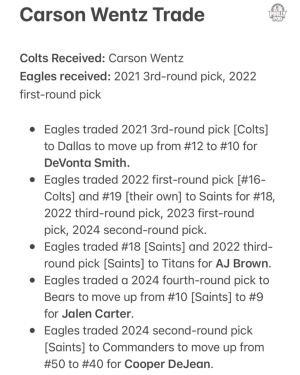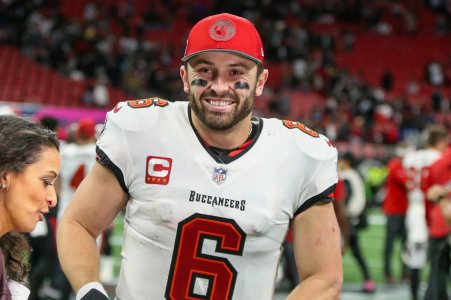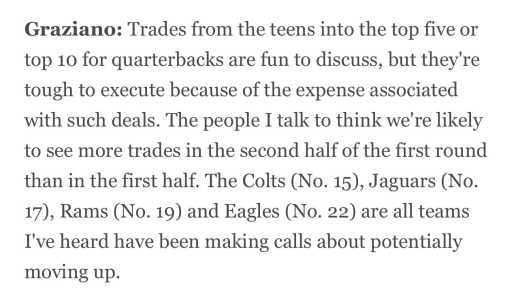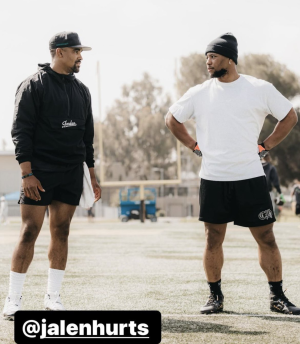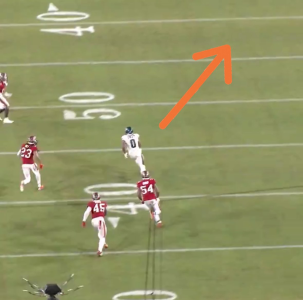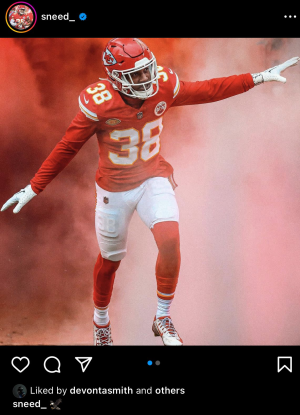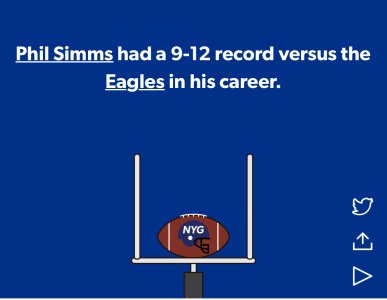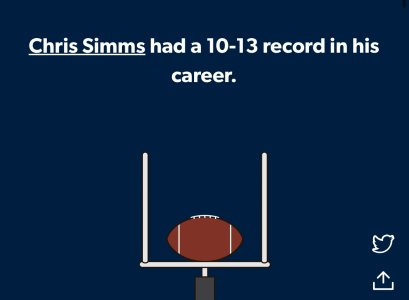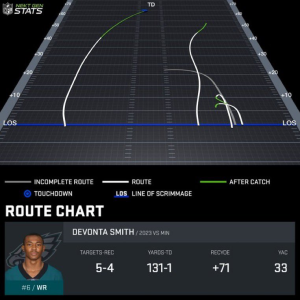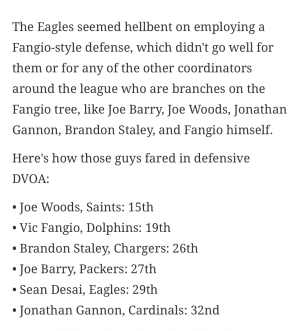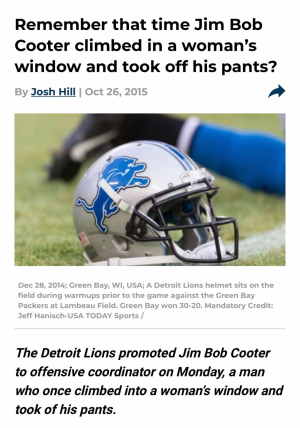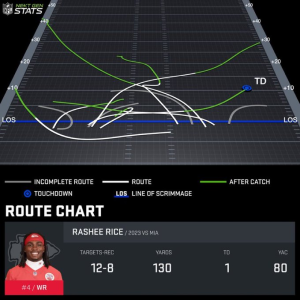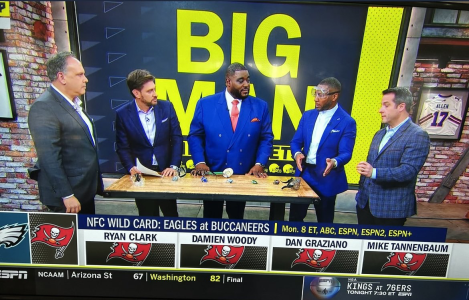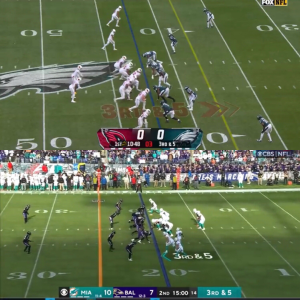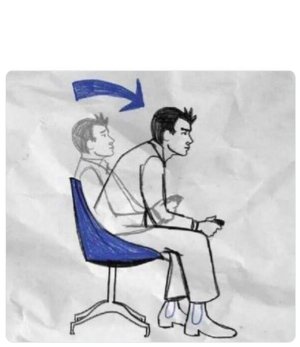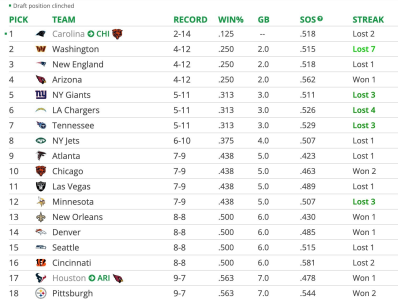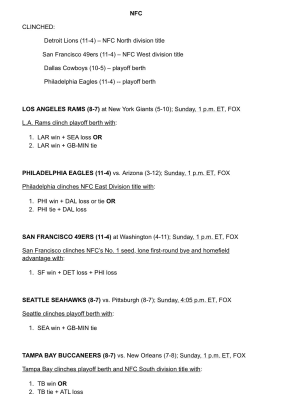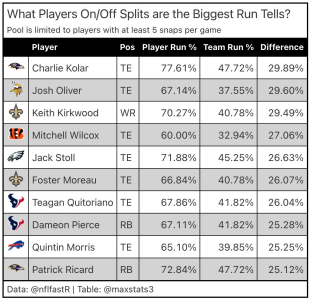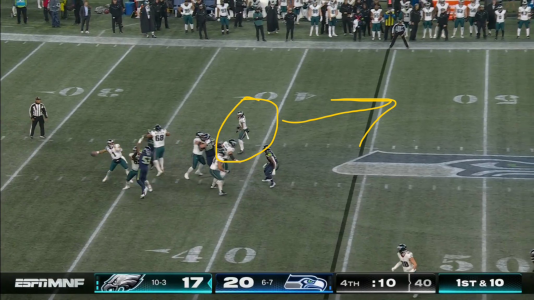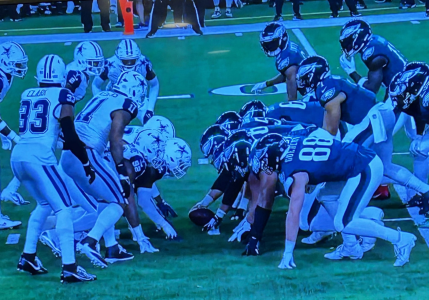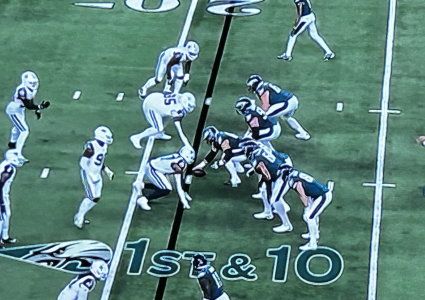- 34,984
- 16,885
- Joined
- Aug 4, 2005
3. DeVonta Smith, Alabama (6-foot-0, 172 pounds)
Amite, La. (Amite); Age: 22.46
A three-year starter at Alabama, Smith played the X receiver position in Sarkisian’s offense, leading the Tide in receiving each of the last two years including a record-breaking 2020 season. Despite sharing targets with Jeudy, Ruggs, Waddle and others during his time in Tuscaloosa, he leaves with the most receiving yards (3,965) and touchdown catches (46) in SEC history, breaking Chase’s conference single-season records as well.
Despite a frail build and average stopwatch speed, Smith is natural in everything he does, finding space, finishing catches and not going down easy (he is tougher and more competitive than most 225-pound receivers). The Alabama coaches used him across the formation and routinely highlighted him as having the best hands on the team, accounting for only seven drops on 268 catchable targets in his career. Overall, Smith doesn’t have an ideal size/speed profile, leading to legitimate durability concerns, but his explosive athleticism, instinctive route-running and natural hands are what make him a polished playmaker in the Marvin Harrison mold, projecting as a starting Z receiver.
4. Kadarius Toney, Florida (5-foot-11, 189 pounds)
Mobile, Ala. (Blount); Age: 22.26
A one-year starter at Florida, Toney lined up across the formation in head coach Dan Mullen’s offense. He saw snaps in the backfield, slot and outside. A former high school quarterback, he was listed as an “athlete” on the Gators’ roster and battled injuries and transition issues his first three seasons before leading Florida in receptions and receiving yards as a senior.
A loose, elastic athlete, Toney routinely makes the first man miss with special start/stop twitch, frustrating would-be tacklers and creating explosive plays. While he is an improved route-runner, he remains a work-in-progress with his steps and tempo and his freelancing will backfire at times. Overall, Toney is still more of a gadget player than polished receiver (and his off-field and durability will be debated in war rooms), but he boasts the one-step burst, body balance and underrated toughness to be a big-play ignitor. He projects as a versatile NFL weapon on offense and special teams.
All-22 Takeaway: “And for my next trick…” – I feel like that is what Toney whispers to himself each time he touches the football. He might as well be an escape artist with plays like this touchdown against Missouri. Lined up in the slot, Toney takes the screen and allows his start/stop athleticism and contact balance to do the rest. His elusiveness makes even the most athletic defenders appear awkward in their pursuit.
5. Terrace Marshall Jr., LSU (6-foot-3, 203 pounds)
Bossier City, La. (Parkway); Age: 20.89
A two-year starter at LSU, Marshall lined up outside as a sophomore before moving inside to the “Y” slot position in offensive coordinator Steve Ensminger’s scheme. Prior to leading the Tigers in receiving in 2020, he put himself on the NFL radar in LSU’s record-breaking offense in 2019 with 13 receiving touchdowns, which would have been the LSU single-season record if not for the remarkable production by Chase (20 touchdowns) and Justin Jefferson (1 that season.
that season.
Marshall has the build-up acceleration to eat cushion without breaking stride and looks like a basketball big man at the catch point. He uses body position and catch radius to reel in off-target throws. Similar in ways to Courtland Sutton as a prospect, he tends to rely on his size/speed and needs to hone his urgency and route mechanics for the next level. Overall, Marshall faces an adjustment period as he develops his separation skills vs. NFL coverage, but he is a field-stretcher who can climb the ladder and give his quarterback a large strike zone. He projects as an inside/outside NFL starter.
6. Rashod Bateman, Minnesota (6-foot-2, 210 pounds)
Tifton, Ga. (Tift County); Age: 21.42
A three-year starter at Minnesota, Bateman lined up across the formation in offensive coordinator Mike Sanford’s offense, playing the X, Y and Z positions over his college career. After passing on SEC offers (including his home-state school, Georgia) to stick with Minnesota out of high school, he was an immediate contributor for the Gophers and set the school’s single-season records for receptions and receiving yards as a sophomore.
Bateman is a natural hands-catcher with length and excellent route savvy, relying on tempo and pacing to create separation. While he is deliberate with his footwork, he lacks explosive burst off the line or out of his breaks and his acceleration falls below NFL standards at the position. Overall, Bateman isn’t a sudden athlete and needs to improve his finishing skills in contested windows. But he is a good-sized target with the detailed route-running to leverage coverage. He projects as a low-ceiling NFL starter.
7. Rondale Moore, Purdue (5-foot-9, 180 pounds)
New Albany, Ind. (Trinity); Age: 20.89
A three-year starter at Purdue, Moore lined up across the formation in head coach Jeff Brohm’s spread scheme, feasting on jets, hand-offs and quick-game targets (screens, shallow crossers/digs/slants, etc.). He put together a remarkable freshman season with an FBS-best 114 catches and school-record 2,215 all-purpose yards, but missed 11 of 18 games the last two seasons due to injury.
While short, Moore plays stout with the fluid ease of movement and instant accelerator to force missed tackles. He was extremely productive on quick-hitting runway routes that were designed for YAC opportunities (71.2 percent of his receiving yards in college came after the catch), but he isn’t a proven commodity on intermediate and downfield routes (finding targets 10-plus yards downfield on his tape was a challenge). Overall, Moore is unpolished in areas and needs to stay on the field, but his explosive lower body, play strength and competitive edge are playmaking ingredients. He projects as a starting NFL slot receiver who can be as impactful as his workload.
8. Elijah Moore, Ole Miss (5-foot-9, 185 pounds)
Fort Lauderdale, Fla. (St. Thomas Aquinas); Age: 21.09
A three-year starter at Ole Miss, Moore was a high-volume slot/backfield target in head coach Lane Kiffin’s up-tempo spread scheme. He thrived with quick, underneath throws (jet sweeps, screens, slants, etc.) and took advantage of being force-fed the football, leading the SEC in catches (10. and receiving yards (149.1) per game in 2020.
and receiving yards (149.1) per game in 2020.
Although he isn’t super explosive, Moore plays fast, decisive and dependable and can be used as a match-up receiver in space, tracking the ball and making defenders miss. He was more of a specialty receiver in college and has plenty to prove as a downfield target. Overall, Moore doesn’t have the tape of a well-rounded receiver, but he is an athletic and controlled route runner with strong hands. He projects as a flexible chess piece who can be as productive as his volume.
All-22 Takeaway: There weren’t many downfield targets on Moore’s tape, but he took advantage of his opportunities. Lined up at the top of the screen against Vanderbilt, he runs a simple sluggo route, forcing the cornerback to commit on the slant and then bursting downfield toward the end zone. The cornerback recovered to make the final result interesting, but Moore did a great job tracking and finishing the catch to the ground for six points.
9. Amari Rodgers, Clemson (5-foot-10, 211 pounds)
Knoxville, Tenn. (Catholic); Age: 21.60
A three-year starter at Clemson, Rodgers lined up primarily in the slot in offensive coordinator Tony Elliott’s shotgun spread scheme. He moved around the formation and thrived on quick targets (screens, sweeps, etc.). He was Trevor Lawrence’s favorite target in 2020 and finished his career No. 6 in school history with 181 catches.
Rodgers is very natural catching the ball in stride and there is a rumble pack on the clicker when you watch his tape because you feel his play strength and toughness. He has elusive feet to shake defenders and settle in zones, but he still requires maturation as a downfield route runner. Overall, Rodgers might struggle to win on the outside vs. NFL corners, but he is a cranked-up competitor with the play strength, instincts and acceleration similar to Deebo Samuel He projects as a versatile starting slot receiver with special teams skills.
All-22 Takeaway: This clip helps illustrate what I mean when I say you can feel Rodgers’ play strength. Lined up in the slot vs. Notre Dame’s Jeremiah Owusu-Koramoah, Rodgers sticks his foot in the ground and bursts outside, giving true freshman quarterback D.J. Uiagalelei an open target. Owusu-Koramoah’s athleticism allows him to quickly recover and this should have been nothing more than 5-yard gain. However, Rodgers’ play strength allows him to remain unfazed by the tackle attempt and Owusu-Koramoah goes flying off him. He then runs through two more tackles before he is gang-tackled out of bounds, turning a 5-yard gain into a 30-yard chunk play.
10. Tutu Atwell, Louisville (5-foot-9, 175 pounds)
Miami, Fla. (Northwestern); Age: 21.56
A three-year starter at Louisville, Atwell lined up primarily in the slot in head coach Scott Satterfield’s offense, feasting on crossers, verticals and quick throws (jet sweeps, screens, etc.). A high school quarterback, he transitioned to receiver full-time for the Cardinals and finished his career No. 8 in school history in receiving yards (2,307) and tied for No. 5 in touchdown grabs (21).
Atwell has sudden feet and playmaking speed to separate before and after the catch, racing by coverage to consistently take the top off the defense. However, he is a small target with obvious play strength limitations and durability concerns. Overall, Atwell has a skill set very similar to Marquise Brown: vastly undersized with more drops than ideal, but his speed stresses every level of the defense. He projects a home-run hitting slot option.
11. D’Wayne Eskridge, Western Michigan (5-foot-9, 188 pounds)
Bluffton, Ind. (Bluffton); Age: 24.10
A three-year starter at Western Michigan, Eskridge lined up in the slot and to the boundary in head coach Tim Lester’s offensive scheme. After a short stint as a two-way player in 2019, he returned to receiver full-time in 2020 and had a prolific senior season with 100-plus receiving yards in five of WMU’s six games when he registered a catch of at least 47 yards in each contest.
With his ability to turn small plays into big ones, Eskridge is the definition of a playmaker due to his explosive feet and ability to mix his speeds as naturally as you or I breathe. He can out-athlete opponents in the Mid-American Conference, but that won’t always be the case in the NFL and needs scale back the wild tendencies. Overall, Eskridge is undersized and must sharpen his route tree, but he is a gifted athlete with the speed, toughness and promising pass-catching traits to warrant early NFL playing time on offense and special teams.
All-22 Takeaway: Lined up at the bottom of the screen against Toledo, Eskridge uses his speed to quickly reach the void in zone coverage, getting his head turned to find the football. To get the football there before the safety, the quarterback fires a seed and Eskridge shows off his athletic body control to adjust mid-air, snatch the ball and continue his quest for the end zone. His athleticism and ball skills make this play look much simpler than it is.
12. Dyami Brown, North Carolina (6-foot-1, 195 pounds)
Charlotte, N.C. (West Mecklenburg); Age: 21.49
A two-year starter at North Carolina, Brown lined up at left wide receiver in offensive coordinator Phil Longo’s scheme and established himself as the offense’s go-to downfield threat. The only player in school history with multiple 1,000-yard receiving seasons, he averaged over 20 yards per catch the last two years and his 18.7 career average is second-best in program history.
An above-average athlete, Brown has excellent one-cut acceleration and separation quickness and he is highly skilled at the double-move (head jab, quick settling of his feet, etc.). Some scouts have questioned whether he has the play strength to make a living on the outside vs. NFL corners. Overall, Brown isn’t quite as reliable as Stefon Diggs, but he has similar size, speed and fluid adjustment skills. He projects as a starting-level NFL receiver with the big-play ability to rack up touchdowns.
All-22 Takeaway: Brown is an artist when it comes to setting up and executing double-moves. Lined up at the bottom of the screen vs. Notre Dame, the moment he gets the corner to turn his hips, he settles his feet for a split-second and seamlessly hits the gas vertically. The underthrow allows the Irish corner to recover and contend the catch point, but Brown is able to slow, track and finish, which set up first-and-goal for the Tar Heels.
13. Tylan Wallace, Oklahoma State (5-foot-11, 193 pounds)
Fort Worth, Texas (South Hills); Age: 21.96
A three-year starter at Oklahoma State, Wallace was the Z receiver in offensive coordinator Kasey Dunn’s version of the air raid offense. He lined up primarily to the right of the formation. He consistently created explosive plays and produced a first down on 73.7 percent of his catches while becoming the fifth player in school history to reach 200 career receptions.
Wallace plays with impressive route movements from set-up to stem and shows the tracking skills and focus to rebound the football. With his ability to play through contact, he is a fun player with the ball in the air. However, the difficulty level of winning contested catches in the NFL compared to the Big 12 will be substantial. Overall, Wallace has only average size and speed, but he is a route technician with the play strength, body control and catch radius to make plays at every level of the field. He projects as an NFL starter if he stays healthy.
14. Amon-Ra St. Brown, USC (6-foot-1, 195 pounds)
Anaheim Hills, Calif. (Mater Dei); Age: 21.51
A three-year starter at USC, St. Brown was the X receiver in offensive coordinator Graham Harrell’s spread scheme. He lined up inside and outside on the left of the formation. Considered one of the most refined high school receivers in the modern era, he made an immediate impact and finished his career No. 11 in USC history with 178 receptions.
Despite average size, he can play above the rim and be a ball-winner as he adjusts to the ball in flight and contorts his frame. While he has the foot quickness to uncover, his separation windows will be much smaller vs. NFL coverage. Overall, St. Brown won’t strike fear in the hearts of opponents with speed or suddenness, but he is ultra-competitive with the body control and polish to be a reliable NFL target. He projects best in the slot.
15. Nico Collins, Michigan (6-foot-4, 215 pounds)
Birmingham, Ala. (Clay-Chalkville); Age: 22.11
A two-year starter at Michigan, Collins lined up both inside and outside in offensive coordinator Josh Gattis’ pro spread scheme. He never reached 40 catches in a season with unimpressive production, but the Wolverines’ inconsistent quarterback play limited his statistical output.
Collins is a plus athlete for his size with the foot quickness and body control to win above the rim. While he shows flashes of a playmaker, he must consistently play up to his size and improve on tight-window throws. Overall, Collins isn’t an explosive or energetic player who will consistently separate underneath, but he is an impressive height, weight, speed prospect with the smooth routes and dependability to push for an NFL starting role (N’Keal Harry-style player).
16. Seth Williams, Auburn (6-foot-3, 225 pounds)
Cottondale, Ala. (Bryant); Age: 21.05
A three-year starter at Auburn, Williams was the X receiver in offensive coordinator Chad Morris’ spread scheme while lining up inside and outside. He made an immediate impact with the Tigers and led the team in receiving yards as a sophomore and junior. He’s just the fourth player in school history to reach 2,100 receiving yards in his career.
A good-sized athlete, Williams is a smooth, balanced mover with excellent play strength and hand-eye coordination to out-rebound the football. He understands route nuance, but doesn’t sink or explode in/out of his breaks and wasn’t a YAC threat in college – less than a third (32.2 percent) of his receiving yards came after the catch. Overall, Williams doesn’t play with suddenness to create separation and his inconsistencies are frustrating, but he is a ball-winner with the physical profile and athletic body control to win contested catches. He projects as an NFL possession receiver with starting ability.
All-22 Takeaway: Kentucky cornerback Kelvin Joseph is tall, long and twitchy, but Williams’ size and physical ball skills gave him the advantage on this corner fade at the goal line. While he might not have great separation quickness, Williams has the ball-winning skills to make plays like this.
17. Cade Johnson, South Dakota State (5-foot-10, 186 pounds)
Papillion, Neb. (Bellevue West); Age: 23.05
A three-year starter at South Dakota State, Johnson lined up in the slot and backfield in offensive coordinator Jason Eck’s scheme and was used across the formation (heavy motion, end-arounds, jet sweeps). Growing up in Nebraska’s backyard, he went overlooked by the Huskers and went from walk-on to one of the most productive players in South Dakota State history. He ranks top-five in school history in receiving yards (2,872) and receiving scores (2 despite no 2020 season.
despite no 2020 season.
Johnson gives off Dennis Northcutt vibes with his toughness and smooth acceleration while reaching his top speed with his second step (Minnesota struggled to guard him on the 2019 tape). He plays with polish, but needs to show improved trust in the details to execute with consistent timing. Overall, Johnson is undersized and lacks ideal experience vs. top competition, but he can uncover and be a threat after the catch. He projects as a dependable slot option.
18. Shi Smith, South Carolina (5-foot-10, 186 pounds)
Union, S.C. (Union County); Age: 22.51
A four-year starter at South Carolina, Smith was the top target in former offensive coordinator Mike Bobo’s scheme. He lined up primarily in the slot. He saw immediate playing time and targets despite sharing the field with Deebo Samuel and Bryan Edwards and became the go-to weapon in 2020 while passing Sterling Sharpe for the No. 4 spot in career receptions (174) at South Carolina.
Smith is always running full-go and displays the foot quickness to separate and the ball skills to make acrobatic grabs. He feasted on a lot of quick-hitting, underneath targets and relies more on dynamic acceleration than crafty movements as a route-runner. Overall, Smith needs to be more consistent as a finisher and rhythmic with his patterns, but he has outstanding play speed and competitive toughness with the “my ball” attitude required for slot work. He projects as an immediate NFL contributor on offense and special teams.
19. Josh Palmer, Tennessee (6-foot-1, 210 pounds)
Brampton, Ontario (St. Thomas Aquinas); Age: 21.60
A four-year starter at Tennessee, Palmer was the Z receiver in former offensive coordinator Jim Chaney’s scheme. He became just the sixth Canadian to letter for the Volunteers. With only one career 100-yard receiving performance in 36 starts, his production was unimpressive, although below-average quarterback play at Tennessee was a main culprit.
Palmer has vacuum hands and natural tracking skills to win the catch point, registering only four drops (none in 2020) on 164 targets in his college career. He has enough speed to eliminate cushions, stack corners and win over the top, flashing playmaking skills when given the opportunity. Overall, Palmer doesn’t have an explosive gear, but his downfield work, ball skills and toughness are NFL-quality. He projects as a depth piece with starter potential in the right situation.
All-22 Takeaway: Alabama cornerback Patrick Surtain II was the 2020 SEC Defensive Player of the Year, allowing only two touchdowns in 13 games. He surrendered one of those touchdowns to Palmer on this outside vertical route, which is where the former Tennessee receiver is at his best. Lined up at the bottom of the screen, Palmer quickly stacks Surtain and cuts him off before beautifully tracking the football over his shoulder. He even earns bonus points for getting two feet down in the end zone before his momentum takes him out of bounds.
20. Demetric Felton, UCLA (5-foot-9, 189 pounds)
Temecula, Calif. (Great Oak); Age: 22.79
A three-year starter at UCLA, Felton was initially a wide receiver before moving to running back in head coach Chip Kelly’s pro-style spread scheme. He was productive whenever he touched the football for the Bruins, both in volume (led the Pac-12 with 165.8 all-purpose yards per game in 2020) and big plays (had four touchdowns of 75-plus yards in 2019, a UCLA single-season record).
Primarily a running back in college, Felton will require time to sharpen his awareness and skills, but his route construction, break quickness and ball skills were impressive during Senior Bowl practices at receiver. Regardless of how he gets the ball, the explosive movements and home run speed are there for him to threaten opponents in different ways. Overall, Felton comes with fit and refinement questions, but he can be a match-up weapon with his flexibility out of the backfield or at receiver. He projects best in the slot and as a return man.
Amite, La. (Amite); Age: 22.46
A three-year starter at Alabama, Smith played the X receiver position in Sarkisian’s offense, leading the Tide in receiving each of the last two years including a record-breaking 2020 season. Despite sharing targets with Jeudy, Ruggs, Waddle and others during his time in Tuscaloosa, he leaves with the most receiving yards (3,965) and touchdown catches (46) in SEC history, breaking Chase’s conference single-season records as well.
Despite a frail build and average stopwatch speed, Smith is natural in everything he does, finding space, finishing catches and not going down easy (he is tougher and more competitive than most 225-pound receivers). The Alabama coaches used him across the formation and routinely highlighted him as having the best hands on the team, accounting for only seven drops on 268 catchable targets in his career. Overall, Smith doesn’t have an ideal size/speed profile, leading to legitimate durability concerns, but his explosive athleticism, instinctive route-running and natural hands are what make him a polished playmaker in the Marvin Harrison mold, projecting as a starting Z receiver.
4. Kadarius Toney, Florida (5-foot-11, 189 pounds)
Mobile, Ala. (Blount); Age: 22.26
A one-year starter at Florida, Toney lined up across the formation in head coach Dan Mullen’s offense. He saw snaps in the backfield, slot and outside. A former high school quarterback, he was listed as an “athlete” on the Gators’ roster and battled injuries and transition issues his first three seasons before leading Florida in receptions and receiving yards as a senior.
A loose, elastic athlete, Toney routinely makes the first man miss with special start/stop twitch, frustrating would-be tacklers and creating explosive plays. While he is an improved route-runner, he remains a work-in-progress with his steps and tempo and his freelancing will backfire at times. Overall, Toney is still more of a gadget player than polished receiver (and his off-field and durability will be debated in war rooms), but he boasts the one-step burst, body balance and underrated toughness to be a big-play ignitor. He projects as a versatile NFL weapon on offense and special teams.
All-22 Takeaway: “And for my next trick…” – I feel like that is what Toney whispers to himself each time he touches the football. He might as well be an escape artist with plays like this touchdown against Missouri. Lined up in the slot, Toney takes the screen and allows his start/stop athleticism and contact balance to do the rest. His elusiveness makes even the most athletic defenders appear awkward in their pursuit.
5. Terrace Marshall Jr., LSU (6-foot-3, 203 pounds)
Bossier City, La. (Parkway); Age: 20.89
A two-year starter at LSU, Marshall lined up outside as a sophomore before moving inside to the “Y” slot position in offensive coordinator Steve Ensminger’s scheme. Prior to leading the Tigers in receiving in 2020, he put himself on the NFL radar in LSU’s record-breaking offense in 2019 with 13 receiving touchdowns, which would have been the LSU single-season record if not for the remarkable production by Chase (20 touchdowns) and Justin Jefferson (1
 that season.
that season.Marshall has the build-up acceleration to eat cushion without breaking stride and looks like a basketball big man at the catch point. He uses body position and catch radius to reel in off-target throws. Similar in ways to Courtland Sutton as a prospect, he tends to rely on his size/speed and needs to hone his urgency and route mechanics for the next level. Overall, Marshall faces an adjustment period as he develops his separation skills vs. NFL coverage, but he is a field-stretcher who can climb the ladder and give his quarterback a large strike zone. He projects as an inside/outside NFL starter.
6. Rashod Bateman, Minnesota (6-foot-2, 210 pounds)
Tifton, Ga. (Tift County); Age: 21.42
A three-year starter at Minnesota, Bateman lined up across the formation in offensive coordinator Mike Sanford’s offense, playing the X, Y and Z positions over his college career. After passing on SEC offers (including his home-state school, Georgia) to stick with Minnesota out of high school, he was an immediate contributor for the Gophers and set the school’s single-season records for receptions and receiving yards as a sophomore.
Bateman is a natural hands-catcher with length and excellent route savvy, relying on tempo and pacing to create separation. While he is deliberate with his footwork, he lacks explosive burst off the line or out of his breaks and his acceleration falls below NFL standards at the position. Overall, Bateman isn’t a sudden athlete and needs to improve his finishing skills in contested windows. But he is a good-sized target with the detailed route-running to leverage coverage. He projects as a low-ceiling NFL starter.
7. Rondale Moore, Purdue (5-foot-9, 180 pounds)
New Albany, Ind. (Trinity); Age: 20.89
A three-year starter at Purdue, Moore lined up across the formation in head coach Jeff Brohm’s spread scheme, feasting on jets, hand-offs and quick-game targets (screens, shallow crossers/digs/slants, etc.). He put together a remarkable freshman season with an FBS-best 114 catches and school-record 2,215 all-purpose yards, but missed 11 of 18 games the last two seasons due to injury.
While short, Moore plays stout with the fluid ease of movement and instant accelerator to force missed tackles. He was extremely productive on quick-hitting runway routes that were designed for YAC opportunities (71.2 percent of his receiving yards in college came after the catch), but he isn’t a proven commodity on intermediate and downfield routes (finding targets 10-plus yards downfield on his tape was a challenge). Overall, Moore is unpolished in areas and needs to stay on the field, but his explosive lower body, play strength and competitive edge are playmaking ingredients. He projects as a starting NFL slot receiver who can be as impactful as his workload.
8. Elijah Moore, Ole Miss (5-foot-9, 185 pounds)
Fort Lauderdale, Fla. (St. Thomas Aquinas); Age: 21.09
A three-year starter at Ole Miss, Moore was a high-volume slot/backfield target in head coach Lane Kiffin’s up-tempo spread scheme. He thrived with quick, underneath throws (jet sweeps, screens, slants, etc.) and took advantage of being force-fed the football, leading the SEC in catches (10.
 and receiving yards (149.1) per game in 2020.
and receiving yards (149.1) per game in 2020.Although he isn’t super explosive, Moore plays fast, decisive and dependable and can be used as a match-up receiver in space, tracking the ball and making defenders miss. He was more of a specialty receiver in college and has plenty to prove as a downfield target. Overall, Moore doesn’t have the tape of a well-rounded receiver, but he is an athletic and controlled route runner with strong hands. He projects as a flexible chess piece who can be as productive as his volume.
All-22 Takeaway: There weren’t many downfield targets on Moore’s tape, but he took advantage of his opportunities. Lined up at the top of the screen against Vanderbilt, he runs a simple sluggo route, forcing the cornerback to commit on the slant and then bursting downfield toward the end zone. The cornerback recovered to make the final result interesting, but Moore did a great job tracking and finishing the catch to the ground for six points.
9. Amari Rodgers, Clemson (5-foot-10, 211 pounds)
Knoxville, Tenn. (Catholic); Age: 21.60
A three-year starter at Clemson, Rodgers lined up primarily in the slot in offensive coordinator Tony Elliott’s shotgun spread scheme. He moved around the formation and thrived on quick targets (screens, sweeps, etc.). He was Trevor Lawrence’s favorite target in 2020 and finished his career No. 6 in school history with 181 catches.
Rodgers is very natural catching the ball in stride and there is a rumble pack on the clicker when you watch his tape because you feel his play strength and toughness. He has elusive feet to shake defenders and settle in zones, but he still requires maturation as a downfield route runner. Overall, Rodgers might struggle to win on the outside vs. NFL corners, but he is a cranked-up competitor with the play strength, instincts and acceleration similar to Deebo Samuel He projects as a versatile starting slot receiver with special teams skills.
All-22 Takeaway: This clip helps illustrate what I mean when I say you can feel Rodgers’ play strength. Lined up in the slot vs. Notre Dame’s Jeremiah Owusu-Koramoah, Rodgers sticks his foot in the ground and bursts outside, giving true freshman quarterback D.J. Uiagalelei an open target. Owusu-Koramoah’s athleticism allows him to quickly recover and this should have been nothing more than 5-yard gain. However, Rodgers’ play strength allows him to remain unfazed by the tackle attempt and Owusu-Koramoah goes flying off him. He then runs through two more tackles before he is gang-tackled out of bounds, turning a 5-yard gain into a 30-yard chunk play.
10. Tutu Atwell, Louisville (5-foot-9, 175 pounds)
Miami, Fla. (Northwestern); Age: 21.56
A three-year starter at Louisville, Atwell lined up primarily in the slot in head coach Scott Satterfield’s offense, feasting on crossers, verticals and quick throws (jet sweeps, screens, etc.). A high school quarterback, he transitioned to receiver full-time for the Cardinals and finished his career No. 8 in school history in receiving yards (2,307) and tied for No. 5 in touchdown grabs (21).
Atwell has sudden feet and playmaking speed to separate before and after the catch, racing by coverage to consistently take the top off the defense. However, he is a small target with obvious play strength limitations and durability concerns. Overall, Atwell has a skill set very similar to Marquise Brown: vastly undersized with more drops than ideal, but his speed stresses every level of the defense. He projects a home-run hitting slot option.
11. D’Wayne Eskridge, Western Michigan (5-foot-9, 188 pounds)
Bluffton, Ind. (Bluffton); Age: 24.10
A three-year starter at Western Michigan, Eskridge lined up in the slot and to the boundary in head coach Tim Lester’s offensive scheme. After a short stint as a two-way player in 2019, he returned to receiver full-time in 2020 and had a prolific senior season with 100-plus receiving yards in five of WMU’s six games when he registered a catch of at least 47 yards in each contest.
With his ability to turn small plays into big ones, Eskridge is the definition of a playmaker due to his explosive feet and ability to mix his speeds as naturally as you or I breathe. He can out-athlete opponents in the Mid-American Conference, but that won’t always be the case in the NFL and needs scale back the wild tendencies. Overall, Eskridge is undersized and must sharpen his route tree, but he is a gifted athlete with the speed, toughness and promising pass-catching traits to warrant early NFL playing time on offense and special teams.
All-22 Takeaway: Lined up at the bottom of the screen against Toledo, Eskridge uses his speed to quickly reach the void in zone coverage, getting his head turned to find the football. To get the football there before the safety, the quarterback fires a seed and Eskridge shows off his athletic body control to adjust mid-air, snatch the ball and continue his quest for the end zone. His athleticism and ball skills make this play look much simpler than it is.
12. Dyami Brown, North Carolina (6-foot-1, 195 pounds)
Charlotte, N.C. (West Mecklenburg); Age: 21.49
A two-year starter at North Carolina, Brown lined up at left wide receiver in offensive coordinator Phil Longo’s scheme and established himself as the offense’s go-to downfield threat. The only player in school history with multiple 1,000-yard receiving seasons, he averaged over 20 yards per catch the last two years and his 18.7 career average is second-best in program history.
An above-average athlete, Brown has excellent one-cut acceleration and separation quickness and he is highly skilled at the double-move (head jab, quick settling of his feet, etc.). Some scouts have questioned whether he has the play strength to make a living on the outside vs. NFL corners. Overall, Brown isn’t quite as reliable as Stefon Diggs, but he has similar size, speed and fluid adjustment skills. He projects as a starting-level NFL receiver with the big-play ability to rack up touchdowns.
All-22 Takeaway: Brown is an artist when it comes to setting up and executing double-moves. Lined up at the bottom of the screen vs. Notre Dame, the moment he gets the corner to turn his hips, he settles his feet for a split-second and seamlessly hits the gas vertically. The underthrow allows the Irish corner to recover and contend the catch point, but Brown is able to slow, track and finish, which set up first-and-goal for the Tar Heels.
13. Tylan Wallace, Oklahoma State (5-foot-11, 193 pounds)
Fort Worth, Texas (South Hills); Age: 21.96
A three-year starter at Oklahoma State, Wallace was the Z receiver in offensive coordinator Kasey Dunn’s version of the air raid offense. He lined up primarily to the right of the formation. He consistently created explosive plays and produced a first down on 73.7 percent of his catches while becoming the fifth player in school history to reach 200 career receptions.
Wallace plays with impressive route movements from set-up to stem and shows the tracking skills and focus to rebound the football. With his ability to play through contact, he is a fun player with the ball in the air. However, the difficulty level of winning contested catches in the NFL compared to the Big 12 will be substantial. Overall, Wallace has only average size and speed, but he is a route technician with the play strength, body control and catch radius to make plays at every level of the field. He projects as an NFL starter if he stays healthy.
14. Amon-Ra St. Brown, USC (6-foot-1, 195 pounds)
Anaheim Hills, Calif. (Mater Dei); Age: 21.51
A three-year starter at USC, St. Brown was the X receiver in offensive coordinator Graham Harrell’s spread scheme. He lined up inside and outside on the left of the formation. Considered one of the most refined high school receivers in the modern era, he made an immediate impact and finished his career No. 11 in USC history with 178 receptions.
Despite average size, he can play above the rim and be a ball-winner as he adjusts to the ball in flight and contorts his frame. While he has the foot quickness to uncover, his separation windows will be much smaller vs. NFL coverage. Overall, St. Brown won’t strike fear in the hearts of opponents with speed or suddenness, but he is ultra-competitive with the body control and polish to be a reliable NFL target. He projects best in the slot.
15. Nico Collins, Michigan (6-foot-4, 215 pounds)
Birmingham, Ala. (Clay-Chalkville); Age: 22.11
A two-year starter at Michigan, Collins lined up both inside and outside in offensive coordinator Josh Gattis’ pro spread scheme. He never reached 40 catches in a season with unimpressive production, but the Wolverines’ inconsistent quarterback play limited his statistical output.
Collins is a plus athlete for his size with the foot quickness and body control to win above the rim. While he shows flashes of a playmaker, he must consistently play up to his size and improve on tight-window throws. Overall, Collins isn’t an explosive or energetic player who will consistently separate underneath, but he is an impressive height, weight, speed prospect with the smooth routes and dependability to push for an NFL starting role (N’Keal Harry-style player).
16. Seth Williams, Auburn (6-foot-3, 225 pounds)
Cottondale, Ala. (Bryant); Age: 21.05
A three-year starter at Auburn, Williams was the X receiver in offensive coordinator Chad Morris’ spread scheme while lining up inside and outside. He made an immediate impact with the Tigers and led the team in receiving yards as a sophomore and junior. He’s just the fourth player in school history to reach 2,100 receiving yards in his career.
A good-sized athlete, Williams is a smooth, balanced mover with excellent play strength and hand-eye coordination to out-rebound the football. He understands route nuance, but doesn’t sink or explode in/out of his breaks and wasn’t a YAC threat in college – less than a third (32.2 percent) of his receiving yards came after the catch. Overall, Williams doesn’t play with suddenness to create separation and his inconsistencies are frustrating, but he is a ball-winner with the physical profile and athletic body control to win contested catches. He projects as an NFL possession receiver with starting ability.
All-22 Takeaway: Kentucky cornerback Kelvin Joseph is tall, long and twitchy, but Williams’ size and physical ball skills gave him the advantage on this corner fade at the goal line. While he might not have great separation quickness, Williams has the ball-winning skills to make plays like this.
17. Cade Johnson, South Dakota State (5-foot-10, 186 pounds)
Papillion, Neb. (Bellevue West); Age: 23.05
A three-year starter at South Dakota State, Johnson lined up in the slot and backfield in offensive coordinator Jason Eck’s scheme and was used across the formation (heavy motion, end-arounds, jet sweeps). Growing up in Nebraska’s backyard, he went overlooked by the Huskers and went from walk-on to one of the most productive players in South Dakota State history. He ranks top-five in school history in receiving yards (2,872) and receiving scores (2
 despite no 2020 season.
despite no 2020 season.Johnson gives off Dennis Northcutt vibes with his toughness and smooth acceleration while reaching his top speed with his second step (Minnesota struggled to guard him on the 2019 tape). He plays with polish, but needs to show improved trust in the details to execute with consistent timing. Overall, Johnson is undersized and lacks ideal experience vs. top competition, but he can uncover and be a threat after the catch. He projects as a dependable slot option.
18. Shi Smith, South Carolina (5-foot-10, 186 pounds)
Union, S.C. (Union County); Age: 22.51
A four-year starter at South Carolina, Smith was the top target in former offensive coordinator Mike Bobo’s scheme. He lined up primarily in the slot. He saw immediate playing time and targets despite sharing the field with Deebo Samuel and Bryan Edwards and became the go-to weapon in 2020 while passing Sterling Sharpe for the No. 4 spot in career receptions (174) at South Carolina.
Smith is always running full-go and displays the foot quickness to separate and the ball skills to make acrobatic grabs. He feasted on a lot of quick-hitting, underneath targets and relies more on dynamic acceleration than crafty movements as a route-runner. Overall, Smith needs to be more consistent as a finisher and rhythmic with his patterns, but he has outstanding play speed and competitive toughness with the “my ball” attitude required for slot work. He projects as an immediate NFL contributor on offense and special teams.
19. Josh Palmer, Tennessee (6-foot-1, 210 pounds)
Brampton, Ontario (St. Thomas Aquinas); Age: 21.60
A four-year starter at Tennessee, Palmer was the Z receiver in former offensive coordinator Jim Chaney’s scheme. He became just the sixth Canadian to letter for the Volunteers. With only one career 100-yard receiving performance in 36 starts, his production was unimpressive, although below-average quarterback play at Tennessee was a main culprit.
Palmer has vacuum hands and natural tracking skills to win the catch point, registering only four drops (none in 2020) on 164 targets in his college career. He has enough speed to eliminate cushions, stack corners and win over the top, flashing playmaking skills when given the opportunity. Overall, Palmer doesn’t have an explosive gear, but his downfield work, ball skills and toughness are NFL-quality. He projects as a depth piece with starter potential in the right situation.
All-22 Takeaway: Alabama cornerback Patrick Surtain II was the 2020 SEC Defensive Player of the Year, allowing only two touchdowns in 13 games. He surrendered one of those touchdowns to Palmer on this outside vertical route, which is where the former Tennessee receiver is at his best. Lined up at the bottom of the screen, Palmer quickly stacks Surtain and cuts him off before beautifully tracking the football over his shoulder. He even earns bonus points for getting two feet down in the end zone before his momentum takes him out of bounds.
20. Demetric Felton, UCLA (5-foot-9, 189 pounds)
Temecula, Calif. (Great Oak); Age: 22.79
A three-year starter at UCLA, Felton was initially a wide receiver before moving to running back in head coach Chip Kelly’s pro-style spread scheme. He was productive whenever he touched the football for the Bruins, both in volume (led the Pac-12 with 165.8 all-purpose yards per game in 2020) and big plays (had four touchdowns of 75-plus yards in 2019, a UCLA single-season record).
Primarily a running back in college, Felton will require time to sharpen his awareness and skills, but his route construction, break quickness and ball skills were impressive during Senior Bowl practices at receiver. Regardless of how he gets the ball, the explosive movements and home run speed are there for him to threaten opponents in different ways. Overall, Felton comes with fit and refinement questions, but he can be a match-up weapon with his flexibility out of the backfield or at receiver. He projects best in the slot and as a return man.




